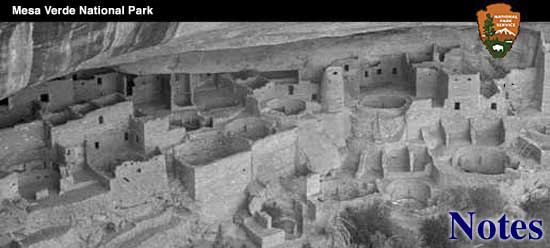

|
The Mesa Verde Museum has been completely overhauled and the material in the exhibit cases has been rearranged. New labels, set at an angle to the display shelves, brighten up the cases and reduce showcase fatigue. A more natural sequence has been achieved in the display of material, so that a comprehensive story is presented to the visitor as he goes through the building. We are glad to announce the following additions to the museum collections. All are now on display. -oOo- UNFIRED BOWL OF CLIFF DWELLER POTTERY. The sherds of an unfired bowl, found on the west side of the park, in Rock Canon, Ruin #11, have been glued together. There were sufficient sherds to almost complete the bowl. This unusual specimen, found in the condition previous to firing, had all the earmarks of a splendid vessel. What particular crisis or event prevented the completion of this bowl will no doubt remain one of the many unsolved mysteries of this mesa. The bowl, typical black-on-white Cliff Dweller ware, measures 33 centimeters (13 inches) in diameter and 14.5 centimeters (5-3/4 inches) in depth. The decoration is plainly visible, though of a light brown color now, instead of black. The sherds are very crumbly and quickly disintegrate when placed in water.
EARLY PUEBLO WARE. Late in April, 1932, the road grader while preparing the ruin roads for spring travel, uncovered an early pueblo burial. Skeletal remains were almost entirely decomposed so that little identification could be made. The largest fragment was part of the skull, showing the burial to be that of an adult with marked deformation of the occiput. Two vessels accompanying the burial were found in excellent condition and are typical of the early pueblo ware.
The bowl, a coiled vessel of the indented type, is 2 centimeters (8-1/2 inches) in diameter and 7 centimeters (2-3/4 inches) in depth. It has an interior decoration, greenish black on a pearl gray ground. The outside of the vessel is corrugated with rubbed spirals. This spiral effect runs from base to rim and was produced by some unusual method of rubbings. The pitcher of gourd like shape is 12.5 centimeters in height (5 inches) and 10.5 centimeters (4-1/4 inches) in diameter at the largest circumference. Black on white ware. A series of black triangles around the rim point downward and a second series of triangles, at the base of the neck, point upward. -oOo- BASKET MAKER III WARE. The restoration of six more pieces of the material obtained by Earl H. Morris, of the Carnegie Institute, just south of the Mancos River in 1929, almost completes the work on this collection.**
-oOo- The whole, loaned to the park by the University of Colorado, now consists of 48 vessels of varying size and shape. The early stage of pottery making, before the slip and decoration was used, is well illustrated by this exhibit. The illustration shows the three types repaired this winter, the taller olla in the center measuring 45.5 centimeters (18 inches) in height.
-OoO- BIRD PENDANT AND BONE COUNTERS. Five small articles turned over the museum by Mr. T. J. Porter, of the Montezuma Valley, are attracting a great deal of interest. A bird pendant, of pink shell, depicts a large bird with the head of a snake in its bill. A hole for the eye is drilled through the bird's head, and two shallow holes are found in the head of the snake on only one side of the pendant. This latter arrangement gives obverse and reverse sides. A hole drilled through the back the bird permits its suspension by means of a cord. This pendant was picked up in a field west of the town of Dolores, Colorado. It is an unusual find in this section of the Southwest. Its type has often been found in Southern Arizona, particularly in Mimbres Valley ruins. A group of four bone counters were found in a grave along the Dolores River. Averaging about 2.7 centimeters (1-1/8 inch) in length each is marked on one side by deeply scratched lines. Similar bone dice are described by Culin1 as having been found in prehistoric graves at Tanner Springs, Arizona, and in Pueblo Penasca Blanca in Chaco Canon, New Mexico. Woodbury2 reports a gaming piece of this type coming from the Paradox Valley, and Roberts3 found three in the Piedra District of Southwestern Colorado.
HOHOKAM POTTERY. The finding within recent years that the Southwest contains a prehistoric pottery distinct and different from tho pueblo type is important in pottery studios. The Red-on-Buff ware excavated in certain Hohokam sites in Southern Arizona, presents a fundamental difference in the technique of manufacture. Where the Basketmaker and Pueblo Pottery evolves from the mould to the coiled type of construction, we find this group using the anvil and paddle method. The process is clearly shown on vessel interiors and the finding of stone anvils of specialized shape and form. Woodward4 and Haury5 each report similar findings in recent excavations.
The Mesa Verde Museum is fortunate in obtaining a number of vessels of this type. These, the gift of the Los Angeles Museum of History, Science and Art, were found in the Grewe Site, Gila Valley, Arizona, by the Van Bergen—Los Angeles Museum Expedition in 1931. There are five pieces and a series of sherds in the collection, namely:
All are Red-on-Buff ware with the exception of the one flat palette. These so called paint palettes are made of slate with decorated border, as shown in the illustration.
| ||||||||||||
| <<< Previous | > Cover < | Next >>> |
vol3-1c.htm
14-Oct-2011